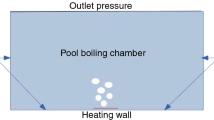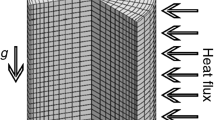Abstract
A numerical scheme for simulating the subcooled flow boiling of water and water-based nanofluids was developed. At first, subcooled flow boiling of water was simulated by the Eulerian multiphase scheme. Then the simulation results were compared with previous experimental data and a good agreement was observed. In the next step, subcooled flow boiling of water-based nanofluid was modeled. In the previous studies in this field, the nanofluid assumed as a homogeneous liquid and the two-phase scheme was used to simulate its boiling. In the present study, a new scheme was used to model the nanofluid boiling. In this scheme, to model the nanofluid flow boiling, three phases, water, vapor and nanoparticles were considered. The Eulerian–Eulerian approach was used for modeling water–vapor interphase and Eulerian–Lagrangian scheme was selected to observe water-nanoparticle interphase behavior. The results from the nanofluid boiling modeling were validated with an experimental investigation. The results of the present work and experimental data were consistent. The addition of 0.0935 % volume fraction of nanoparticles in pure liquid boiling flow increases the vapor volume fraction at the outlet almost by 40.7 %. The results show the three-phase model is a good approach to simulate the nanofluid boiling flow.


















Similar content being viewed by others
Abbreviations
- A tc :
-
Fraction of heater area occupied by bubbles
- a if :
-
Interfacial area concentration (m−1)
- C p :
-
Specific heat (J kg−1 K−1)
- C w :
-
Specific heat of the wall (J kg−1 K−1)
- d :
-
Diameter (m)
- d B :
-
Mean bubble diameter in the bulk flow
- d w :
-
Bubble departure diameter on the wall
- F lg :
-
Action of interfacial forces from vapor on liquid (N)
- F gl :
-
Action of interfacial forces from liquid on vapor (N)
- f :
-
Bubble departure frequency (Hz)
- α :
-
Void fraction
- G :
-
Mass flux (kg m−2 s−1)
- g :
-
Gravitational constant (m s−2)
- H :
-
Enthalpy (J kg−1)
- h :
-
Interfacial heat transfer coefficient (J kg−1)
- h fg :
-
Latent heat of evaporation (J kg−1)
- k :
-
Conductivity (W m−2 K−1)
- m :
-
Mass (kg)
- N a :
-
Active nucleation site density (m−2)
- Nu :
-
Nusselt number
- P :
-
Pressure (N m−2)
- Pr :
-
Prantdl number
- Q c :
-
Heat transfer due to forced convective (W m−2)
- Q e :
-
Heat transfer due to evaporation (W m−2)
- Q tc :
-
Heat transfer due to transient conduction (W m−2)
- Re :
-
Reynolds number
- T :
-
Temperature (K)
- T sub :
-
Liquid subcooling temperature (K) = Tsat − T1
- T sup :
-
Wall superheat temperature (K) = Tw − Tsat
- T w :
-
Wall temperature
- ΔT :
-
Difference in temperature (K)
- t :
-
Time (S)
- u :
-
Velocity (m s−1)
- υ i :
-
Specific volume of discrete bubble ith class (m3 kg−1)
- y + :
-
Non-dimensional distance to the wall
- μ :
-
Viscosity (Pa S)
- ρ :
-
Density (kg m−3)
- σ :
-
Surface tension (N m−1)
- Γ lg :
-
Interfacial mass transfer from vapor to liquid (kg m−3 s−1)
- Γ gl :
-
Interfacial mass transfer from liquid to vapor (kg m−3 s−1)
- eff :
-
Effective
- g :
-
Vapor
- l :
-
Liquid
- p :
-
Particle
- w :
-
Wall
- CHF:
-
Critical heat flux
- Fig:
-
Figure
- ONB:
-
Onset of nucleate boiling
References
Col TDD, Bortolin S (2012) Investigation of dry out during flow boiling in a single microchannel under non-uniform axial heat flux. Int J Therm Sci 57:25–36
Buongiorno PJ, Hu L (2009) Innovative technologies: two-phase heat transfer in water-based nanofluids for nuclear applications, final report. Department of Nuclear Science and Engineering, Nuclear Reactor Laboratory, Massachusetts Institute of Technology, pp 206–222
Xu L, Xu J (2012) Nanofluid stabilizes and enhances convective boiling heat transfer in a single microchannel. Int J Heat Mass Transf 55:5673–5686
Kim I, Jeong YH, Chang SH (2010) An experimental study on CHF enhancement in flow boiling using Al2O3 nano-fluid. Int J Heat Mass Transf 53:1015–1022
Ahn HS, Kim H, Jo H, Kang SH, Chang WP, Kim MH (2010) Experimental study of critical heat flux enhancement during forced convective flow boiling of nanofluid on a short heated surface. Int J Multiph Flow 36:375–384
Kim TI, Chang WJ, Chang SH (2011) Flow boiling CHF enhancement using Al2O3 nanoparticle deposited tube. Int J Heat mass Transf 54:2021–2025
Lee SW, Kim KM, Bang IC (2013) Study on flow boiling critical heat flux enhancement of graphene oxide/water nanofluid. Int J Heat Mass Transf 65:348–356
Lee T, Lee JH, Jeong YH (2013) Flow boiling critical heat flux characteristics of magnetic nanofluid at atmospheric pressure and low mass flux conditions. Int J Heat Mass Transf 56:101–106
Boudouh M, Louhalia Gualous H, De Labacheleria M (2010) Local convective boiling heat transfer and pressure drop of nanofluid in narrow rectangular channels. Appl Therm Eng 30:2619–2631
Henderson K, Park YG, Liu L, Jacobi AM (2010) Flow-boiling heat transfer of R-134a-based nanofluids in a horizontal tube. Int J Heat Mass Transf 53:944–951
Chehade AA, Gualous HL, Masson SL, Fardoun F, Besq A (2013) Boiling local heat transfer enhancement in minichannels using nano fluids. Springer Open J Nanoscale Res Lett 8:130
Sarafraz MM, Hormozi F (2014) Scale formation and subcooled flow boiling heat transfer of CuO–water nano-fluid inside the vertical annulus. Exp Therm Fluid Sci 52:205–214
Sarafraz MM, Hormozi F (2014) Convective boiling and particulate fouling of stabilized CuO-ethylene glycol nano-fluids inside the annular heat exchanger. Int Commun Heat Mass Transf 53:116–123
Abedini E, Behzadmehr A, Sarvari SMH, Mansouri SH (2013) Numerical investigation of subcooled flow boiling of a nanofluid. Int J Therm Sci 64:232–239
Shojaeian M, Koşar A (2015) Pool boiling and flow boiling on micro- and nanostructured surfaces. Exp Therm Fluid Sci 63:45–73
Ciloglu D, Bolukbasi A (2015) A comprehensive review on pool boiling of nanofluids. Appl Therm Eng 84:45–63
Aminfar H, Mohammadpourfard M, Maroofiazar R (2014) Numerical study of non-uniform magnetic fields effects on subcooled nanofluid flow boiling. Prog Nucl Energy 74:232–241
He Y, Men Y, Zhao Y, Lu H, Ding Y (2009) Numerical investigation into the convective heat transfer of TiO2 nanofluids flowing through a straight tube under the laminar flow conditions. Appl Therm Eng 29:1956–1972
Bianco V, Chiacchio F, Manca O, Nardini S (2009) Numerical investigation of nanofluids force convection in circular tubes. Appl Therm Eng 29:3632–3642
Hadad K, Rahimian A, Nematollahi MR (2013) Numerical study of single and two phase models of water/Al2O3 nanofluid turbulent forced convection flow in VVER-1000 nuclear reactor. Ann Nucl Energy 60:287–294
Cheung SCP, Vahaji S, Yeoh GH, Tu JY (2014) Modeling subcooled flow boiling in vertical channels at low pressures—part 1: assessment of empirical correlations. Int J Heat Mass Transf 75:736–753
Menter FR (1994) Two-equation eddy-viscosity turbulence models for engineering applications. AIAA J 32(8):1598–1605
Krepper E, Končar B, Egorov Y (2007) CFD modeling of subcooled boiling—concept, validation and application to fuel assembly design. Nucl Eng Des 237:716–731
Sato Y, Sadatomi M, Sekoguchi K (1981) Momentum and heat transfer in two-phase bubble flow—I. Int J Multiph Flow 7(2):167–177
Burns AD, Frank T, Hamill I, Shi JM (2004) The Favre averaged drag model for turbulent disprsion in Eulerian multi-phase flows. In: 5th International conference multiphase flow, Yokoshoma, Japan
Antal SP, Lahey JRRT, Flaherty JE (1991) Analysis of phase distribution in fully developed laminar bubbly two-phase flow. Int J Multiph Flow 17(5):635–652
Cole R (1960) A photographic study of pool boiling in the region of the critical heat flux. AIChE J 6(4):533–542
Vasefi I, Alizadeh M (2013) A numerical investigation of CuO–water nanofluid in different geometries by two-phase Euler–Lagrange method. World Appl Sci J 26(10):1323–1329
Kim SJ, McKrell T, Buongiorno J, Hu L (2010) Subcooled flow boiling heat transfer of dilute alumina, zinc oxide, and diamond nanofluids at atmospheric pressure. Nucl Eng Des 240:1186–1194
Končar B, Krepper E, Egorov Y (2005) CFD modeling of subcooled flow boiling for nuclear engineering applications. In: International conference nuclear energy for New Europe, Bled, Slovena
Tu JY, Yeoh GH (2002) On numerical modeling of low-pressure subcooled boiling flows. Int J Heat Mass Transf 45:1197–1209
Acknowledgments
The helpful discussion of Dr. Heyhat is highly acknowledged. The authors would like to thank M. Ashrafi and H. Alimoradi for their helpful comments, which have helped the authors in improving the quality of this manuscript.
Author information
Authors and Affiliations
Corresponding author
Rights and permissions
About this article
Cite this article
Valizadeh, Z., Shams, M. Numerical investigation of water-based nanofluid subcooled flow boiling by three-phase Euler–Euler, Euler–Lagrange approach. Heat Mass Transfer 52, 1501–1514 (2016). https://doi.org/10.1007/s00231-015-1675-3
Received:
Accepted:
Published:
Issue Date:
DOI: https://doi.org/10.1007/s00231-015-1675-3




